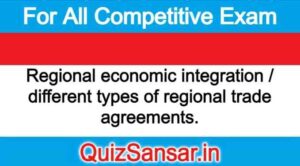
Regional economic integration / different types of regional trade agreements.
Regional Trade Agreements
Regionalism is described in the Dictionary of Trade Policy Terms, as “actions by governments to liberalize or facilitate trade on a regional basis. sometimes through free trade areas or customs unions”. Thus when a group of countries eliminates (artificial) barriers to international trade and competition on a regional than a global scale, then it is known as Regional economic integration. In the WTO context, Regional Trade Agreements (RTAS) have both a more general and more specific meanings: it is more general, because RTAs may be agreements concluded between countries not necessarily belonging to the same geographical region; and it is more specific, because the WTO provisions which relate specifically to conditions of preferential trade liberalization with RTAS. ‘Regional trade agreements have become increasingly popular since the Second World War and it has also become the preferred approach to trade liberalization during the last fifteen years’ (Pal, (2004).
Regional Trade Agreements excludes the Most Favored Nations (MFN) clause of the GATT/WTO, because it gives preferential treatment to the members of the agreement, but it does not give equal treatment to the non members of the agreement. So any such agreement violates the non discrimination principal of GATT/WTO. Regional economic integration agreements are the move towards unhindered trade flows among a group of countries. Regional agreements are deliberated as a right step towards free trade and it is considered good for less developed countries as it provide an instinct to the growth and development process of LDCs (Frankie & Fellow, 1996).
Types of Regional Trade Agreements
The exposure and depth of preferential treatment varies from one RTA to another. Modern RTAs have a tendency to go far beyond tariff cutting exercise. They provide an increasingly complex regulations governing intra trade (e.g. with respect to standards, safeguard provisions, customs administration, etc.) and they frequently provide a preferential regulatory framework for mutual services trade. The most refined RTAS go beyond traditional trade policy mechanisms, and they also include regional rules on investment, competition, environment and labour matters’ (Lynch, 2010). On the basis of economic and policy integration we can differentiate between the following types of regional economic integration agreements
EarnTheFuture: Preferential Trade Agreement (PTA): In PTAs, two or more countries form a trading club or a union and reduce tariffs on imports of each other, ie they exchange tariffs preferences and concessions. The member countries maintain their individual tariffs against the outside world. A good example of such PTA is the commonwealth preference system headed by the United Kingdom.
Free Trade Area (FTA): When two or more countries come together and abolish all tariff duties on their individual tariffs against the rest of the world, we have a free trade association or area. The European Free Trade Area (EFTA) which consists of the so called ‘outer seven’ (viz. Austria, Norway, Denmark, Portugal, Sweden, Switzerland and the UK) is an example of Free Trade Area.
Customs Union: Like a free trade area, a custom union abolishes internal tariffs and other trade restrictions among the members of the union. ‘Custom union is more organized and well-knit than Free Trade Agreement’ (Mannur, 2005). When two or more countries abolish all tariff duties among themselves and adopt a common external tariff barrier against the imports of all goods from the rest of the world, it forms a Custom union. In addition, a custom union develops a common trade policy, such as common external tariffs, relative to other countries. An example is provided by the European Economic Community (EEC).
Common Market: In this case the member countries allow not only for the free movement of goods and services, but also for the free movement of factors of production, such as capital and labour. A common market gradually moves to an combined (or internal) market if the member countries also eliminate other, more concealed barriers to trade arising from differences in national policy, for example regarding product standards or taxation. An example is provided by the European Union (EU). Economic Union: The highest stage of economic integration is reached
EarnTheFuture: when countries form an economic union. An extension of the common/ internal market is an economic union, in which case there is also harmonization of the institutional framework, regarding competition policy, procurement, etc., and a fair degree of policy co-ordination. The economic union therefore provides the counterpart in the real sphere of a monetary union, in which case there is sufficient policy co-ordination to allow for one currency. A combined example is provided by the EU’s Economic and Monetary Union (EMU).






